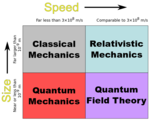فيزياء فلكية
| الفيزياء |
|---|
| تاريخ الفيزياء |
الفيزياء الفلكية Astrophysics هو العلم الذي يربط بين الفيزياء والفلك. يقدم علم الفيزياء القوانين الهامة اللازمة التي يستخدمها الفلكيون. والفيزياء الفلكية تحاول تحديد الطبيعة المادية للنظام الشمسي والنجوم والمجرات والكون كله وأصولها وتطورها.
ويجري علماء الفيزياء (الطبيعة) الفلكية كثيرًا من الدراسات بوساطة التلسكوبات. وتمكنهم التلسكوبات البصرية من رصد الأجرام الفضائية التي تطلق موجات كهرومغنطيسية في أشكال ضوء مرئي وأشعة تحت حمراء. وتستخدم التلسكوبات الراديوية لدراسة الموجات الراديوية التي تبثها أو تعكسها الكواكب والنجوم والمجرات. وتبث مختلف الأجرام الكونية أشعة جاما والأشعة السينية والأشعة فوق البنفسجية. ومثل هذه الموجات يمتصها ـ إلى حد كبير ـ غلاف الأرض الجوي، ومن ثم لا يمكن الكشف عنها بوساطة تلسكوبات على سطح الأرض. ويقوم بدراستها علماء الفيزياء الفلكية عن طريق مختبرات خاصة تحملها مناطيد طبقات الجو العليا والصواريخ والمركبات الفضائية.
ويمكن معرفة الكثير عن الطبيعة المادية للأجرام السماوية عن طريق دراسة الأطوال الموجية للموجات الكهرومغنطيسية التي تُطلقها. وعلى سبيل المثال يعطي تحليل نمط الأطوال الموجية التي ينتجها الضوء القادم من أي نجمٍ معلومات عن كثافته ودرجة حرارته. ويمكن مثل هذا التحليل الطيفي الفيزيائيين الفلكيين أيضًا من تحديد العناصر الكيميائية التي يتكون منها النجم، كما يمكنهم من تحديد كمية هذه العناصر.

ويقدر علماء الفيزياء الفلكية حركة النجم أو المجرة بقياس التحول في الأطوال الموجية للضوء القادم منه. ويطلق على التحول في الضوء الأزرق للجرم السماوي نحو القطاع الأحمر للطيف ـ أو إلى الموجات الأطول، التحول الأحمر. وتشير التحولات الحمراء الضخمة للمجرات البعيدة وأشباه النجوم إلى أنها تتحرك بسرعة مبتعدة عن الأرض. وقد قاد هذا كثيرًا من علماء الفيزياء الفلكية للاعتقاد بأن الكون يتمدد. ومن النظريات التي توفر هذه الملاحظة نظرية الانفجار العظيم التي تنص على أن الكون بدأ بانفجار منذ نحو عشرة أو 20 بليون سنة مضت.
ويشمل البحث في علم الفيزياء الفلكية ـ أيضًا ـ دراسة الإشعاعات الكونية، وهي جسيمات ذات طاقة عالية يعتقد أنها ناجمة عن الشمس والنابضات والمستعرات فائقة التوهج وغيرها من أنواع النجوم. وتساعد دراسات الأشعة الكونية علماء الفيزياء الكونية على فهم أفضل للعمليات النووية التي تحدث داخل مثل هذه النجوم.
. . . . . . . . . . . . . . . . . . . . . . . . . . . . . . . . . . . . . . . . . . . . . . . . . . . . . . . . . . . . . . . . . . . . . . . . . . . . . . . . . . . . . . . . . . . . . . . . . . . . . . . . . . . . . . . . . . . . . . . . . . . . . . . . . . . . . . . . . . . . . . . . . . . . . . . . . . . . . . . . . . . . . . . .
التاريخ
الفيزياء الفلكية الرصدية
Observational astronomy is a division of the astronomical science that is concerned with recording data, in contrast with theoretical astrophysics, which is mainly concerned with finding out the measurable implications of physical models. It is the practice of observing celestial objects by using telescopes and other astronomical apparatus.
The majority of astrophysical observations are made using the electromagnetic spectrum.
الفيزياء الفلكية النظرية

علماء الفيزياء الفلكية
من أبرز علماء هذا العلم :
الترويج
The roots of astrophysics can be found in the seventeenth century emergence of a unified physics, in which the same laws applied to the celestial and terrestrial realms.[1] There were scientists who were qualified in both physics and astronomy who laid the firm foundation for the current science of astrophysics. In modern times, students continue to be drawn to astrophysics due to its popularization by the Royal Astronomical Society and notable educators such as prominent professors Lawrence Krauss, Subrahmanyan Chandrasekhar, Stephen Hawking, Hubert Reeves, Carl Sagan and Neil deGrasse Tyson. The efforts of the early, late, and present scientists continue to attract young people to study the history and science of astrophysics.[2][3][4]
انظر أيضاً
- Astrochemistry
- Astronomical observatories
- Astronomical spectroscopy
- Bremsstrahlung
- Henry Draper Medal
- Hertzsprung–Russell diagram
- High-energy astronomy
- Illustris project
- Important publications in astrophysics
- List of astronomers (includes astrophysicists)
- Neutrino astronomy (future prospects)
- Nucleosynthesis
- Particle accelerator
- Quasar
- Radio astronomy
- Royal Astronomical Society
- Spectroscopy
- Stellar classification
- Timeline of black hole physics
- Timeline of gravitational physics and relativity
- Timeline of knowledge about galaxies, clusters of galaxies, and large-scale structure
- Timeline of white dwarfs, neutron stars, and supernovae
- قائمة علماء الفيزياء الفلكية
- Nucleosynthesis
- مسرع الجسيمات
- الديناميكا الفلكية
- الكيمياء الفلكية
- آشعة كونية
- التلسكوب اللاسلكي
- علم الفلك
- مقياس الطيف
المصادر
الهامش
- ^ Burtt, Edwin Arthur (2003) [First published 1924], The Metaphysical Foundations of Modern Science (second revised ed.), Mineola, NY: Dover Publications, pp. 30, 41, 241–2, ISBN 9780486425511, https://books.google.com/books/about/The_Metaphysical_Foundations_of_Modern_S.html?id=G9WBMa1Rz_kC
- ^ D. Mark Manley (2012). "Famous Astronomers and Astrophysicists". Kent State University. Retrieved 2015-07-17.
- ^ The science.ca team (2015). "Hubert Reeves – Astronomy, Astrophysics and Space Science". GCS Research Society. Retrieved 2015-07-17.
- ^ "Neil deGrasse Tyson". Hayden Planetarium. 2015. Retrieved 2015-07-17.
وصلات خارجية
- International Journal of Modern Physics D from World Scientific
- Cosmic Journey: A History of Scientific Cosmology from the American Institute of Physics
- Prof. Sir Harry Kroto, NL, Astrophysical Chemistry Lecture Series. 8 Freeview Lectures provided by the Vega Science Trust.
- Stanford Linear Accelerator Center, Stanford, California
- Institute for Space Astrophysics and Cosmic Physics
- Astrophysical Journal
- Astronomy and Astrophysics, a European Journal
- Master of Science in Astronomy and Astrophysics
- Ned Wright's Cosmology Tutorial, UCLA



